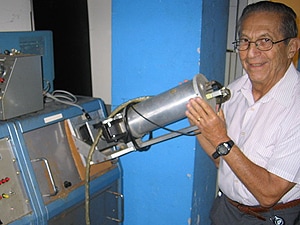July 27, 2012 — Robert S. Ledley, DDS, the trailblazing dentist who invented the first practical whole-body computed tomography (CT) system and alerted researchers to the potential of computers in medicine, has died in Kensington, Maryland. He was 86 years old.
Born in Flushing Meadows, New York, on June 28, 1926, Dr. Ledley earned his DDS at the New York University College of in Dentistry in 1948.
 |
Dr. Robert S. Ledley
|
The dental degree was intended to provide a reliable source of income to support Dr. Ledley's budding interest in theoretical physics. Work toward a master's degree in physics at Columbia University in 1949 brought him into contact with Nobel laureates Hans A. Bethe and Enrico Fermi. Isidor Rabi, who conducted key experiments for the future development of magnetic resonance imaging, headed Columbia's physics department at the time.
Dr. Ledley gained professional prominence in the 1950s and 1960s as an early advocate for computers in medicine and biomedical science. In 1956, he was hired as an assistant professor of electrical engineering at George Washington University School of Engineering and Applied Science in Washington, DC.
In 1960, he founded the National Biomedical Research Foundation (NBRF). The nonprofit institute is devoted to investigating the potential uses of computers in biomedical research. He remained active with the foundation into his 80s, retiring as president and research director of NBRF in 2010.
Dr. Ledley's interest in CT was stirred in 1974 when he learned the neurosurgery department at Georgetown University Medical Center was planning to spend $500,000 for an early CT system, designed by its inventor Sir Godfrey Hounsfield in Nottingham, England, and built by British manufacturer EMI. With Allan M. Cormack, Hounsfield was jointly awarded the 1979 Nobel Prize in Physiology or Medicine for the invention.
Dr. Ledley vowed he could build a CT system for half the price. His starting point was a brochure for the EMI scanner and a book by Cormack covering mathematical algorithms essential for CT image reconstruction.
Dr. Ledley's Automatic Computerized Transverse Axial (ACTA) scanner addressed engineering problems that limited the EMI system to brain scanning. The whole-body imaging capabilities of the ACTA system technically opened the door to the wide range of diagnostic clinical applications that helped CT revolutionize medical imaging practice.
The ACTA scanner was introduced at Georgetown University Medical Center in February 1974. Its clinical utility was first demonstrated on a child with suspected brain trauma from a bicycle accident. The scan was credited with saving the boy's life when it noninvasively detected a subdural hematoma that was successfully treated with surgery.
Scanners based on Dr. Ledley's patented design were built by Digital Information Science Corporation, a firm founded and managed by Dr. Ledley until its sale in 1975 to Pfizer. Early systems cost $300,000.
During a long career, Dr. Ledley also patented an antibiotic quality control testing device used by the US Food and Drug Administration and many pharmaceutical companies. He also is credited for building one of the first digital subtraction fluorography systems.
Dr. Ledley was a founding fellow of the American College of Medical Informatics and authored or coauthored more than 300 peer-reviewed articles.
He was inducted into the National Inventors Hall of Fame in 1990 and received the National Medal of Technology from President Bill Clinton in 1997. The original prototype for ACTA scanner now resides with the Smithsonian Institution Museum of American History.
Comments
Post a Comment